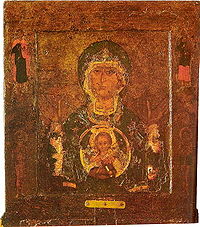Our Lady of the Sign (Novgorod)
| Znamenie | |
|---|---|
| Russian: Знамение (Znameniye), English: Our Lady of the Sign | |
 |
|
| Year | First half of 12th century |
| Type | Orans |
| Dimensions | 59 cm × 57.2 cm (23 in × 22.5 in) |
| Location | Cathedral of St. Sophia, Veliky Novgorod |
Znа́meniye (Russian: Зна́мение) or Our Lady of the Sign is an icon in the orans style, dated at the first half of the 12th century. The icon was painted in medieval Novgorod. It is one of the most revered icons of the Russian Orthodox Church and the main holy of Russian North-West. In past the icon was the main icon of the Novgorod Republic and the symbol of Novgorod sovereignty and republicanism due to the event that has glorified the icon.
The icon symbolizes the pregnancy of the Virgin: it shows Our Lady with hands raised for praying and the figure of the holy infant in her chest in the circle (orans type of icons). The icon is 2-sided: saint Joachim and saint Anne in praying are pictured on the back side. It has a shaft which for an icon indicates the ability to be carried outside.
In the 17th century the paint was refreshed: Macarius, the metropolitan of Moscow, is believed to be the possible executor). The initial ancient paint is retained only in fragments (some of the Virgin’s dress, and the circle around the Jesus). The back side image is absolutely original, in the ancient paint.
The origins of the icon are unknown. The icon is ascribed to be miraculous. The miracle reportedly occurred in 1170, when Novgorod was besieged by the army of Andrei Bogolubsky, the prince of Suzdal. The struggle has become a seminal iconographic theme since.
In 1170 the united army of 4 Russian kingdoms (duchy of Vladimir, duchy of Smolensk, duchy of Murom and duchy of Polotsk) had come toward the walls of Novgorod and laid siege to the city. The further events are described in the Novgorodian saga, cited below.
...
Wikipedia
